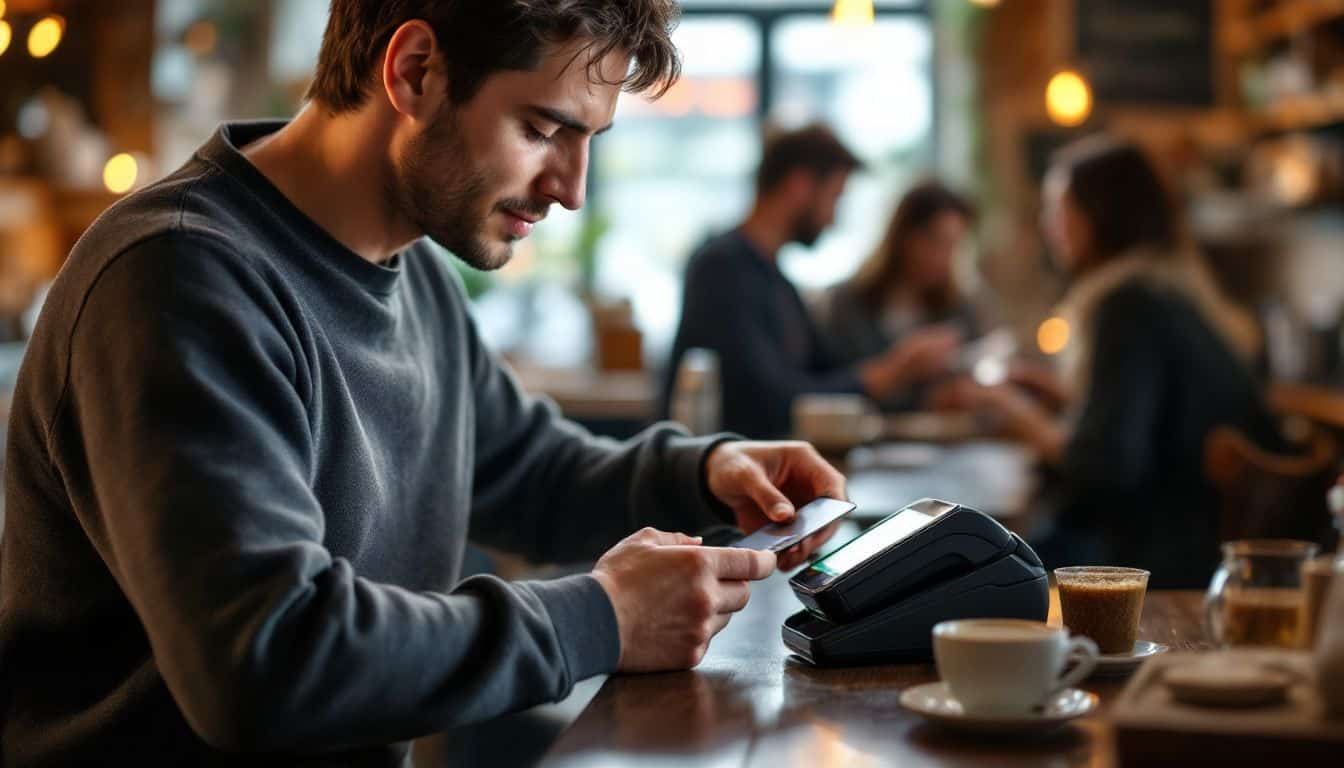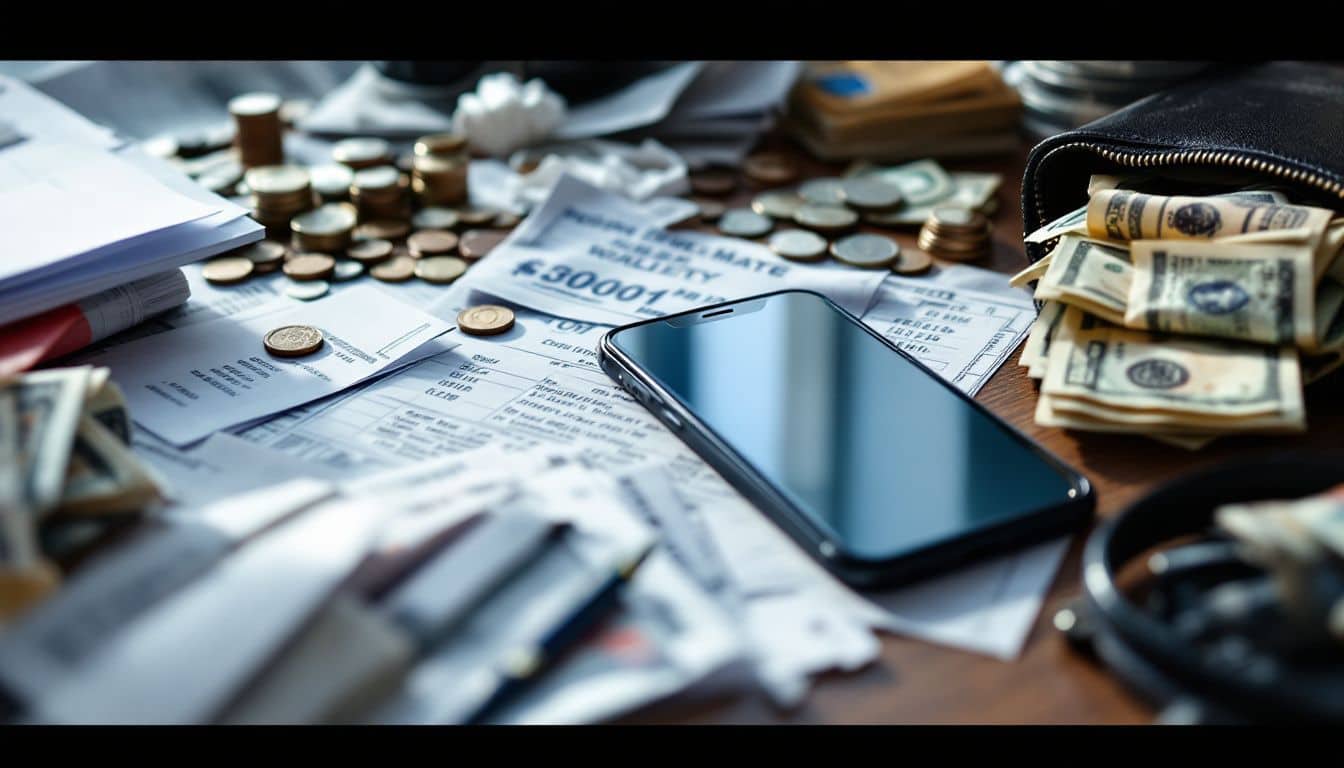Ever lost your wallet and felt that sinking feeling? What if I told you there’s a better way? Digital wallets are changing how we handle money. They’re like magic pockets that store your cash and cards…without the bulk.
What is a digital wallet, you ask? It’s a virtual safe for your payment info. This post will show you four types that make money moves a breeze. Ready for some wallet wizardry?
Key Takeaways
Digital wallets are virtual safes for payment info, used by 89% of Americans for digital payments.
Four main types exist: cryptocurrency, mobile, desktop, and hardware wallets, each with unique features.
These wallets use NFC, MST, and QR codes for quick, contactless payments.
By 2025, over half of all online purchases will use contactless payment technology.
While convenient, digital wallets face challenges like limited acceptance and security concerns, with 80% of people trusting bank security more than other payment options.
Table of Contents
Understanding Digital Wallets

Digital wallets are like magic pockets for your money and cards. They’re software systems that store your payment info and passwords on your phone or computer. No more bulky wallets stuffed with plastic! These digital marvels can hold credit cards, bank details, gift cards, and even your driver’s license.
It’s like having a financial Swiss Army knife in your pocket.
Here’s the kicker – 89% of Americans have already jumped on the digital payment bandwagon. These wallets aren’t just for tech geeks anymore. They’re changing how we pay, making life easier for everyone – even folks without traditional bank accounts.
Plus, they use fancy encryption and tokenization to keep your info safe. It’s like having a tiny Fort Knox in your smartphone!
Operating Mechanisms of Digital Wallets

Digital wallets work like magic – but there’s tech behind the trick. Let’s peek under the hood and see how these money-movers really tick.
Utilize Near-field Communication (NFC)
 NFC tech is like magic for digital wallets. It lets your phone chat with payment terminals without touching. Just wave your device near the reader, and bam! Your payment’s done. Google Wallet uses this neat trick to make paying quick and safe.
NFC tech is like magic for digital wallets. It lets your phone chat with payment terminals without touching. Just wave your device near the reader, and bam! Your payment’s done. Google Wallet uses this neat trick to make paying quick and safe.
NFC: Where your phone becomes your wallet.
NFC works within a tiny range – about an inch and a half. This keeps your data safe from sneaky folks trying to steal it. Plus, it’s super fast. No more fumbling with cash or cards.
Just tap and go!
Employ Magnetic Secure Transmission (MST)

Shifting from NFC to MST, we’re exploring another cool tech for digital wallets. Magnetic Secure Transmission (MST) is like a magic wand for payments. It sends magnetic signals from your phone to card readers.
No touching needed!
MST is a game-changer for digital wallets. It works with old-school card readers too. That’s right – even if a store doesn’t have fancy new tech, you can still use your digital wallet.
MST mimics the swipe of a card… without the actual swipe. It’s like having a shape-shifting credit card in your phone. Cool, right?
Implement QR Codes
 QR codes are the new cool kids on the digital payment block. These funky square patterns pack a punch, letting you zap payments with just a smartphone camera. No need for fancy hardware or special terminals.
QR codes are the new cool kids on the digital payment block. These funky square patterns pack a punch, letting you zap payments with just a smartphone camera. No need for fancy hardware or special terminals.
Just point, click, and pay! It’s no wonder QR codes took off during the pandemic. They’re contact-free and super secure. In China, these little squares dominate the scene – a whopping 85% of mobile payments in 2020 used QR codes.
Talk about a payment revolution!
But QR codes aren’t just for paying. They’re like Swiss Army knives for digital wallets. You can store loyalty cards, coupons, and even event tickets in those pixelated squares. And the best part? They work anywhere.
No spatial limits here! Whether you’re buying street food or shopping online, QR codes have got your back. It’s like having a magic wand for your money – swish and flick, and you’re done!
Varieties of Digital Wallets

Digital wallets come in different flavors – each with its own cool tricks. Want to know more? Keep reading!
Understand Cryptocurrency Wallets

Crypto wallets are like digital safes for your virtual coins. They don’t hold actual money. Instead, they store special keys that let you access and move your crypto. These keys are crucial – lose them, and you lose your coins.
That’s why picking the right wallet matters. Some folks use Magic Eden Wallet to manage their digital assets securely.
There are two main types of crypto wallets: custodial and non-custodial. Custodial wallets are run by companies that keep your keys safe for you. Non-custodial wallets put you in charge of your own keys.
Each has pros and cons. Custodial wallets are easier but less private. Non-custodial offer more control but more responsibility. Hot wallets connect to the internet, while cold wallets stay offline for extra safety.
Your keys, your coins. Not your keys, not your coins.
Explore Mobile Wallets

Mobile wallets are digital magic wands for your money. They’re apps on your phone that hold your payment info. No more bulky wallets or fumbling for cash! Just tap your phone at the store, and voila – you’ve paid.
These digital helpers are catching on fast. In fact, they’re used for over half of all online payments worldwide.
Think of mobile wallets as your financial Swiss Army knife. They’re not just for buying stuff. You can send money to friends, track spending, and even score sweet deals. Apple Pay, Google Pay, and Samsung Pay are some big names in this game.
With a 49% global use rate, mobile wallets are changing how we handle cash. Ignore them, and you might miss out on half your potential payments. That’s a lot of dough!
Discover Desktop Wallets

Desktop wallets pack a punch for digital money management. They’re software programs you install on your computer. These wallets give you full control of your funds and keys. You can access them anytime, even without internet.
Plus, they offer a wider view of your finances than mobile apps.
But wait, there’s more! Desktop wallets shine in security. They’re harder for hackers to crack than online versions. Many let you set up multi-sig features for extra safety. Some popular picks? Exodus, Electrum, and Atomic Wallet.
Next up, let’s dive into hardware wallets – the Fort Knox of digital cash.
Examine Hardware Wallets

Hardware wallets are the top-tier security for digital money. These small devices resemble USB sticks but offer powerful protection. They store your crypto wallet address and private keys offline – keeping them out of hackers’ reach on the internet.
I’ve used one for years, and it’s like having a personal mini-bank with me.
These gadgets excel in safety. They use specialized chips to protect your coins. Even if you connect them to a computer full of viruses, your funds remain secure. Most come with screens for transaction verification.
You approve sends by pressing buttons on the device – it’s hands-on security at its best. For crypto enthusiasts with significant holdings, hardware wallets are an essential tool.
Essential Features of Digital Wallets

Digital wallets pack a punch with cool features. They’re not just about paying – they’re your ticket to a smoother, safer money world.
Enable Contactless Payments
Digital wallets have made contactless payments a breeze. Gone are the days of fumbling for cash or swiping cards. Now, you can pay with a simple tap or wave of your phone. It’s like magic – but it’s real tech wizardry!
Contactless is the new king of convenience.
This nifty feature uses NFC or QR codes to zap payment info securely. Over half of all online buys will use contactless tech by 2025. That’s huge! It’s not just fast – it’s also safer than old-school cards.
No more worries about skimmers or lost wallets. Your digital wallet keeps your money under lock and key… in the cloud!
Enhance Security Measures
Contactless payments are cool, but security’s where digital wallets really shine. These high-tech money holders pack some serious safety punch. They use fancy encryption to keep your cash info under wraps.
Plus, you’ll need a secret code or your fingerprint to get in. It’s like having a tiny Fort Knox in your pocket!
But wait, there’s more! Digital wallets use a trick called tokenization. It’s like a secret code for your money. Each time you buy something, it creates a one-time code. So even if bad guys get their hands on it, they can’t use it again.
And if you lose your phone? No sweat! You can freeze your wallet from another device faster than you can say “where’s my phone?” It’s money magic that keeps your cash safe and sound.
Facilitate Integration with Other Apps
Digital wallets play nice with other apps. They’re like the cool kids who get along with everyone. You can link your favorite shopping apps, banking tools, and even loyalty programs to your digital wallet.
This means you can do more without switching between apps. It’s like having a Swiss Army knife for your finances.
I’ve found this super handy. Last week, I bought coffee and used my digital wallet to pay. The app automatically applied my loyalty points and gave me a discount. Sweet! Next up, we’ll look at the pros and cons of these digital money magicians.
Advantages and Challenges of Digital Wallets

Digital wallets offer speed and ease, but they face hurdles like limited acceptance and security risks. Want to know more? Keep reading!
Assess Convenience and Speed
Digital wallets make money magic happen in a snap. No more fumbling for cash or cards at checkout. Just tap your phone, and voilà! Your payment’s done. It’s like having a genie in your pocket, granting wishes at lightning speed.
These e-wallets cut transaction times to mere seconds, perfect for our fast-paced world.
But speed isn’t the only trick up their sleeve. Digital wallets remember your payment info, loyalty cards, and even your favorite stores. It’s like having a super-smart assistant who knows exactly what you need.
And for us geeks? It’s a tech playground. We can explore new payment apps, fiddle with NFC settings, and get into contactless transactions. Next up, let’s chat about how widely accepted these digital wonders are.
Consider Broad Acceptance Issues
Digital wallets face a big hurdle: not everyone takes them. You might love paying with your phone, but some stores still only take cash or cards. This can be a real pain when you’re out and about.
Imagine trying to buy coffee, but the shop doesn’t accept your fancy digital wallet. Bummer!
Compatibility is another headache. Different wallets work with different systems. Your PayPal might not play nice with a store’s checkout. Or your Apple Pay could get the cold shoulder from an Android-loving merchant.
It’s like trying to fit a square peg in a round hole. These issues can make digital wallets less useful than good old plastic cards. Next up, let’s talk about the worries that keep some folks from jumping on the digital wallet bandwagon.
Evaluate Security Concerns
While broad acceptance is crucial, security remains a top worry for digital wallet users. Geeks, you’ll be glad to know that banks are still seen as the most trusted option. In fact, over 80% of folks trust their bank’s security more than other payment choices.
But don’t let that lull you into a false sense of safety.
Digital wallets have their own set of risks. Old-school authentication methods can leave your data exposed. Plus, if your card gets stolen, you might face a headache trying to remove it from your digital wallet.
It’s not all doom and gloom, though. Many wallets use neat tricks like tokenization to keep your info safe. They also employ two-factor authentication to add an extra layer of protection.
Still, no system is perfect, so stay alert and keep your digital wallet as secure as your physical one.
People Also Ask
What’s a digital wallet, and how does it work?
A digital wallet is like a magic money pouch on your phone. It stores your payment info, making buying stuff a breeze. You can use it to pay at stores, online, or send cash to friends. It’s safer than carrying a bunch of cards around.
What are the four main types of digital wallets?
The fab four of digital wallets are: Smartphone wallets (Apple Pay, Google Pay), Online payment systems (PayPal, Stripe Checkout), Cryptocurrency wallets (Bitcoin, Ethereum), and Bank-specific wallets (Capital One, Chase). Each type has its own perks, so pick what fits your style!
How do digital wallets keep my money safe?
Digital wallets are like Fort Knox for your cash. They use fancy tech like tokenization and encryption to guard your info. Some even use your face or fingerprint to make sure it’s really you. It’s way harder for bad guys to steal your identity this way.
Can I use my digital wallet everywhere?
Not quite yet, but we’re getting there! More and more places are jumping on the digital wallet train. You can use them at most stores, restaurants, and even some ATMs. Just look for signs that say “contactless payment” or show a wireless symbol.
What’s the difference between a digital wallet and a mobile banking app?
Think of a digital wallet as a Swiss Army knife for your money, while a mobile banking app is more like a single tool. Digital wallets can hold multiple cards, loyalty rewards, and even tickets. Banking apps usually just let you check your balance and move money around.
Do I need a smartphone to use a digital wallet?
Nope! While smartphones are the most common way to use digital wallets, they’re not the only game in town. Some smartwatches, tablets, and even old-school computers can get in on the action. It’s all about finding what works for you.
References
https://www.investopedia.com/terms/d/digital-wallet.asp
https://blog.717cu.com/resources/education/financial-education-blog/the-history-of-digital-wallets
https://www.techtarget.com/whatis/definition/digital-wallet
https://www.helcim.com/guides/accepting-tap-and-pay-nfc-payments/
https://ironvest.com/blog/what-is-a-digital-wallet/ (2024-01-28)
https://www.ncbi.nlm.nih.gov/pmc/articles/PMC8890473/
https://www.investopedia.com/terms/b/bitcoin-wallet.asp
https://dashdevs.com/blog/digital-wallet-types-guide/
https://corporatefinanceinstitute.com/resources/cryptocurrency/digital-wallet/
https://adamosoft.com/blog/fintech-software-development/types-of-digital-wallets/
https://www.southeastbank.com/blog/4-digital-wallet-security-features-you-need-know/
https://www.citizensbank.com/learning/is-digital-wallet-safe.aspx
https://paydo.com/blog/weighing-up-digital-wallets-pros-and-cons/ (2024-04-17)
https://scand.com/company/blog/digital-wallet-benefits-and-disadvantages/ (2023-11-13)
https://www.paymentsjournal.com/researchers-uncover-security-issues-in-digital-wallets/ (2024-08-23)
